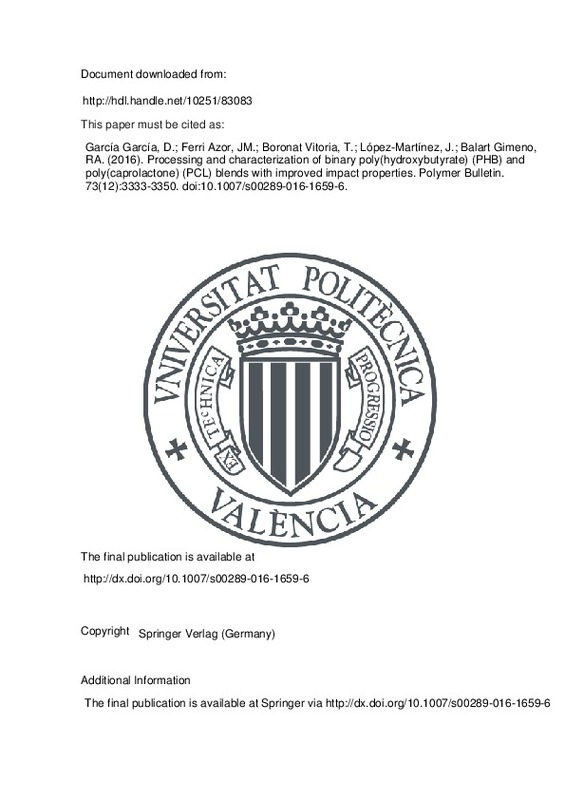Arrieta MP, Samper MD, López J, Jiménez A (2014) Combined effect of poly(hydroxybutyrate) and plasticizers on polylactic acid properties for film intended for food packaging. J Polym Environ 22:460–470. doi: 10.1007/s10924-014-0654-y
Zhang M, Thomas NL (2011) Blending polylactic acid with polyhydroxybutyrate: the effect on thermal, mechanical, and biodegradation properties. Adv Polym Technol 30:67–79. doi: 10.1002/adv.20235
Simoes CL, Viana JC, Cunha AM (2009) Mechanical properties of poly(epsilon-caprolactone) and poly(lactic acid) blends. J Appl Polym Sci 112:345–352. doi: 10.1002/app.29425
[+]
Arrieta MP, Samper MD, López J, Jiménez A (2014) Combined effect of poly(hydroxybutyrate) and plasticizers on polylactic acid properties for film intended for food packaging. J Polym Environ 22:460–470. doi: 10.1007/s10924-014-0654-y
Zhang M, Thomas NL (2011) Blending polylactic acid with polyhydroxybutyrate: the effect on thermal, mechanical, and biodegradation properties. Adv Polym Technol 30:67–79. doi: 10.1002/adv.20235
Simoes CL, Viana JC, Cunha AM (2009) Mechanical properties of poly(epsilon-caprolactone) and poly(lactic acid) blends. J Appl Polym Sci 112:345–352. doi: 10.1002/app.29425
Wei L, Liang S, McDonald AG (2015) Thermophysical properties and biodegradation behavior of green composites made from polyhydroxybutyrate and potato peel waste fermentation residue. Ind Crops Prod 69:91–103. doi: 10.1016/j.indcrop.2015.02.011
Dias M, Moraes Antunes MC, Santos AR Jr, Felisberti MI (2008) Blends of poly(3-hydroxybutyrate) and poly(p-dioxanone): miscibility, thermal stability and biocompatibility. J Mater Sci Mater Med 19:3535–3544. doi: 10.1007/s10856-008-3531-1
Catiker E, Sancaktar E (2014) Blends of poly(3-hydroxybutyrate) with poly(b-alanine) and its derivatives. J Appl Polym Sci 131:40484. doi: 10.1002/app.40484
Janigova I, Lacik I, Chodak I (2002) Thermal degradation of plasticized poly(3-hydroxybutyrate) investigated by DSC. Polym Degrad Stab 77:35–41. doi: 10.1016/s0141-3910(02)00077-0
Abdelwahab MA, Flynn A, Chiou B-S, Imam S, Orts W, Chiellini E (2012) Thermal, mechanical and morphological characterization of plasticized PLA-PHB blends. Polym Degrad Stab 97:1822–1828. doi: 10.1016/j.Polymdegradstab.05.036
Ma P, Cai X, Wang W, Duan F, Shi D, Lemstra PJ (2014) Crystallization behavior of partially crosslinked poly(beta-hydroxyalkonates)/poly(butylene succinate) Blends. J Appl Polym Sci 131:41020. doi: 10.1002/app.41020
Ma P, Hristova-Bogaerds DG, Zhang Y, Lemstra PJ (2014) Enhancement in crystallization kinetics of the bacterially synthesized poly(beta-hydroxybutyrate) by poly(butylene succinate). Polym Bull 71:907–923. doi: 10.1007/s00289-014-1101-x
Al-Salah HA (1998) Crystallization and morphology of poly(ethylene succinate) and poly(beta-hydroxybutyrate) blends. Polym Bull 41:593–600. doi: 10.1007/s002890050406
Gassner F, Owen AJ (1994) Physical-properties of poly(beta-hydroxybutyrate) poly(epsilon-caprolactone) blends. Polymer 35:2233–2236. doi: 10.1016/0032-3861(94)90258-5
Lovera D, Marquez L, Balsamo V, Taddei A, Castelli C, Muller AJ (2007) Crystallization, morphology, and enzymatic degradation of polyhydroxybutyrate/polycaprolactone (PHB/PCL) blends. Macromol Chem Phys 208:924–937. doi: 10.1002/macp.200700011
Kim BO, Woo SI (1998) Compatibilizing capability of poly(beta-hydroxybutyrate-co-epsilon-caprolactone) in the blend of poly(beta-hydroxybutyrate) and poly(epsilon-caprolactone). Polym Bull 41:707–712. doi: 10.1007/s002890050422
Valdes Garcia A, Ramos Santonja M, Beltran Sanahuja A, del Carmen Garrigos Selva M (2014) Characterization and degradation characteristics of poly (epsilon-caprolactone)-based composites reinforced with almond skin residues. Polym Degrad Stab 108:269–279. doi: 10.1016/j.polymdegradstab.2014.03.011
Patricio T, Bartolo P (2013) Thermal stability of PCL/PLA blends produced by physical blending process. Procedia Eng 59:292–297. doi: 10.1016/j.proeng.2013.05.124
Harrison KL, Jenkins MJ (2004) The effect of crystallinity and water absorption on the dynamic mechanical relaxation behaviour of polycaprolactone. Polym Int 53:1298–1304. doi: 10.1002/pi.1517
Fukushima K, Luis Feijoo J, Yang M-C (2013) Comparison of abiotic and biotic degradation of PDLLA, PCL and partially miscible PDLLA/PCL blend. Eur Polym J 49:706–717. doi: 10.1016/j.eurpolymj.2012.12.011
Li Y, Dong Q, Han C, Bian Y, Zhang X, Dong L (2014) Toward environment-friendly composites of poly(e-caprolactone) reinforced with stereocomplex-type poly(L-lactide)/poly(D-lactide). J Appl Polym Sci 131:40208. doi: 10.1002/app.40208
Imre B, Pukanszky B (2013) Compatibilization in bio-based and biodegradable polymer blends. Eur Polym J 49:1215–1233. doi: 10.1016/j.eurpolymj.2013.01.019
Hinueber C, Haeussler L, Vogel R, Bruenig H, Heinrich G, Werner C (2011) Hollow fibers made from a poly(3-hydroxybutyrate)/poly-epsilon-caprolactone blend. eXPRESS Polym Lett 5:643–652. doi: 10.3144/expresspolymlett.2011.62
Kumagai Y, Doi Y (1992) Enzymatic degradation and morphologies of binary blends of microbial poly(3-hydroxy butyrate) with poly(epsilon-caprolactone), poly(1,4-butylene adipate and poly(vinyl acetate). Polym Degrad Stab 36:241–248. doi: 10.1016/0141-3910(92)90062-a
Avella M, Martuscelli E, Raimo M (2000) Review—properties of blends and composites based on poly(3-hydroxy)butyrate (PHB) and poly(3-hydroxybutyrate-hydroxyvalerate) (PHBV) copolymers. J Mater Sci 35:523–545. doi: 10.1023/a:1004740522751
Katsumata K, Saito T, Yu F, Nakamura N, Inoue Y (2011) The toughening effect of a small amount of poly(epsilon-caprolactone) on the mechanical properties of the poly(3-hydroxybutyrate-co-3-hydroxyhexanoate)/PCL blend. Polym J (Tokyo, Jpn) 43:484–492. doi: 10.1038/pj.2011.12
Monticelli O, Calabrese M, Gardella L, Fina A, Gioffredi E (2014) Silsesquioxanes: novel compatibilizing agents for tuning the microstructure and properties of PLA/PCL immiscible blends. Eur Polym J 58:69–78. doi: 10.1016/j.eurpolymj.2014.06.021
Prakalathan K, Mohanty S, Nayak SK (2014) Reinforcing effect and isothermal crystallization kinetics of poly(3-hydroxybutyrate) nanocomposites blended with organically modified montmorillonite. Polym Compos 35:999–1012. doi: 10.1002/pc.22746
Wang L, Zhu W, Wang X, Chen X, Chen G-Q, Xu K (2008) Processability modifications of poly(3-hydroxybutyrate) by plasticizing, blending, and stabilizing. J Appl Polym Sci 107:166–173. doi: 10.1002/app.27004
Mofokeng JP, Luyt AS (2015) Morphology and thermal degradation studies of melt-mixed poly(hydroxybutyrate-co-valerate) (PHBV)/poly(epsilon-caprolactone) (PCL) biodegradable polymer blend nanocomposites with TiO2 as filler. J Mater Sci 50:3812–3824. doi: 10.1007/s10853-015-8950-z
[-]







![[Cerrado]](/themes/UPV/images/candado.png)


